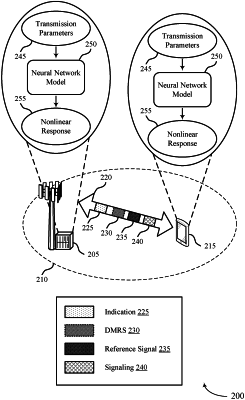| CPC H04W 72/23 (2023.01) [H03F 1/3247 (2013.01); H04L 5/0048 (2013.01); H04W 72/0473 (2013.01)] | 52 Claims |

|
29. An apparatus for wireless communications at a first device, comprising:
a processor, and
memory coupled with the processor, the processor configured to:
transmit an indication configuring a second device to transmit a first reference signal with a first peak to average power ratio and a second reference signal with a second peak to average power ratio that is greater than the first peak to average power ratio;
receive, from the second device, the first reference signal and the second reference signal based at least in part on transmitting the indication;
determine a neural network model and one or more neural network weights corresponding to one or more transmission parameters associated with the second device based at least in part on the first reference signal and the second reference signal;
determine, using the neural network model and based at least in part on the one or more neural network weights, a nonlinear response associated with the second device;
estimate a transmission encoding metric and a reception decoding metric associated with the first reference signal and the second reference signal based at least in part on the nonlinear response, the neural network model, and the one or more neural network weights;
transmit signaling associated with the neural network model and the one or more neural network weights based at least in part on the estimating, wherein the signaling comprises an uplink grant scheduling a transmission that is to be encoded, based at least in part on the transmission encoding metric, to compensate for the nonlinear response; and
communicate with the second device based at least in part on the reception decoding metric.
|